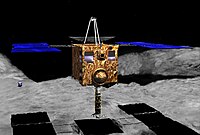
Photo from wikipedia
We aim to use light detection and ranging (LIDAR) to detect dust grains that might be present around asteroid (162173) Ryugu (1999 JU3), the target of the Hayabusa2 mission. LIDAR is currently… Click to show full abstract
We aim to use light detection and ranging (LIDAR) to detect dust grains that might be present around asteroid (162173) Ryugu (1999 JU3), the target of the Hayabusa2 mission. LIDAR is currently used for observing atmospheric aerosols on Earth by measuring the time profile of the return pulse (received light). In the case of Hayabusa2, LIDAR will be used only to determine whether the energy flux of the return pulse exceeds a certain threshold every 133.33 ns. This simplification significantly reduces the amount of down link data. The profile of the return pulse is estimated from iterative observations by changing the thresholds. Here, the performance of the dust counter mode is examined using a breadboard model, a flight model, and an engineering model. For these tests, we develop a new testing device to simulate various time profiles of the return pulse. We also estimate the lower bound of the number density of dust grains that can be detected. It is shown that the LIDAR on board Hayabusa2 is capable of detecting asteroidal dust if dust grains with size similar to the Hayabusa sample exist around the target body and their number density exceeds 105m−3$10^{5}~\mbox{m}^{-3}$.
Journal Title: Space Science Reviews
Year Published: 2017
Link to full text (if available)
Share on Social Media: Sign Up to like & get
recommendations!